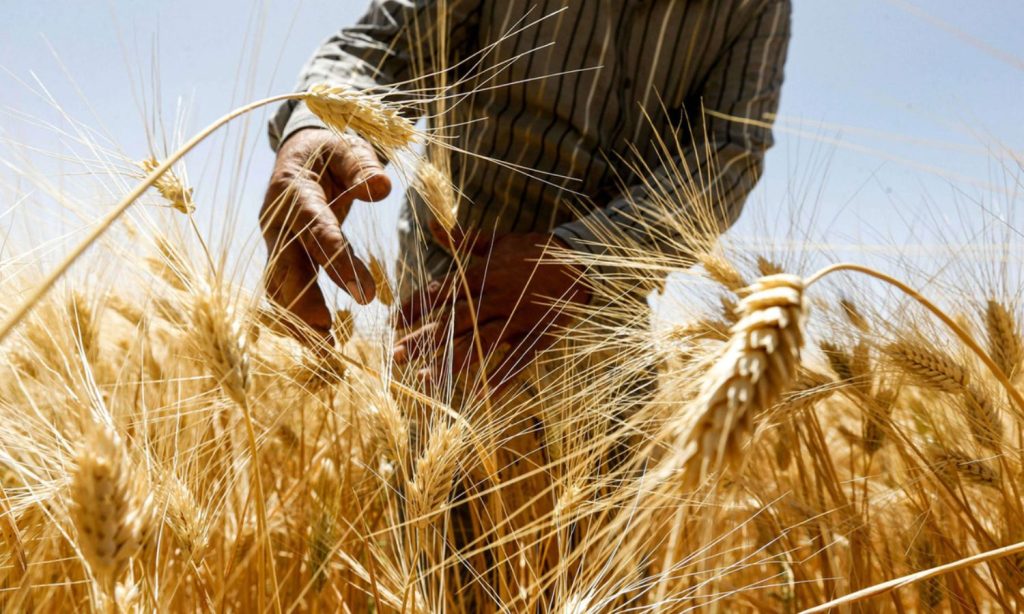Homs – Orwah al-Mundhir
Before the start of the wheat harvest season in Syria, farmers realized the extent of their losses, despite the good production, as the purchase prices offered by the government of the Syrian regime this year are not commensurate with the high costs, which has increased farmers’ suffering and deepened their losses.
The government of the regime set the purchase price of wheat at 2,500 SYP per kilogram, in addition to a reward of 300 SYP in the event that the delivered wheat is considered to be of the first type, while the price of wheat decreases with a decrease in its classification in grain receiving silos.
A few weeks ago, the Presidency of the Council of Ministers approved the price of receiving the wheat crop for the 2023 season at 2,300 SYP per kilo, to return and raise the price to 2,500 with a reward of 300 ٍSYP, in accordance with the recommendations of the Economic Committee.
($1=9000 SYP, according to the S-P Today website that covers the trading rate of the Syrian pound to the dollar).
Lower hay price causes more losses
The decline in the purchase price of wheat was accompanied by a decline in the price of white straw, thus increasing farmers’ losses this season.
White straw is considered one of the outputs of the wheat season, and it is used to feed livestock from sheep and cows. Breeders buy straw from farmers and store it until winter to provide it to livestock. One dunam of wheat produces the same amount of straw as it produces grain.
The increase in the cultivated areas of wheat led to a decrease in the prices of hay as a result of the increase in supply on the one hand and the prevention of exports on the other hand, which increased the losses of farmers in the hay season.
Somar Hilal, a farmer from the city of al-Rastan in the northern countryside of Homs, told Enab Baladi that the price of hay decreased this year due to the large cultivated areas, as the price reached 150 SYP per kilogram, while last year it was about 400 SYP during the harvest season.
Hilal added that the price of hay this year does not cover harvest fees and that storing it for trading is difficult because of the need for large warehouses and the difficulty of transporting it from one place to another.
Exchange rate losses
The purchase price of wheat set by the government is lower than last season, which is 2,000 SYP per kilogram, when compared to the price of the US dollar, as it was equivalent to about half a dollar compared to the exchange rate of the dollar against the Syrian pound at the time, as it was about 3,800 pounds, while today’s exchange rate is close to 9000 pounds against the dollar, according to black market prices.
Qassem Wahoud, a farmer from the al-Houla Plain in the countryside of Homs, told Enab Baladi that the price of wheat this year is “extremely unfair,” and the losses are “heavy,” with the rise in wages for the harvester, which reached 75,000 pounds per dunam, and that the “fair” price last year encouraged farmers to increase planted acreage this year.
Wahoud justified the doubling of the amount of cultivated areas by farmers with the price approved by the government last year, which amounted to almost half a dollar close to the world price. However, this year, according to the current pricing, the price of a kilogram barely reaches 31 US cents, which is almost half the world price.
The price of American durum wheat reached $347 per ton, Argentine to $378 per ton, and French to $245 per ton, according to the World Grain Council, with an annual decline of between 23 and 38%, after the global rise in wheat prices following the Russian invasion of Ukraine.
While the price of a ton of Russian wheat, which is the main resource of the regime’s government, was about $230.
The regime’s government calculates the marketing prices of wheat on the Syrian pound, while production inputs such as fertilizers, seeds, and pesticides rise at the exchange rate.
Youssef Kakhia, an agricultural engineer from the city of Talbiseh in the northern countryside of Homs, told Enab Baladi that the government sold seeds to farmers at 3,000 SYP per kilogram and raised the prices of fertilizers in parallel with the rise in the exchange rate, and the prices of pesticides are calculated in US dollars, while it approved its purchase price of wheat according to the Syrian pound.
Younis al-Hamdan, Director of Homs Agriculture Directorate, told the local Al-Khabar TV that the area of harvestable wheat in the governorate is about 40,000 hectares, while 3,110 tons of wheat were delivered to Syria’s General Establishment for Cereal Processing and Trade (Hoboob) until May 29.
He explained that the areas harvested to date amounted to about 355 hectares of irrigated and rain-fed wheat, the majority of which is in the Talkalakh area, while 346 tons of barley were delivered to the Fodder Corporation.

